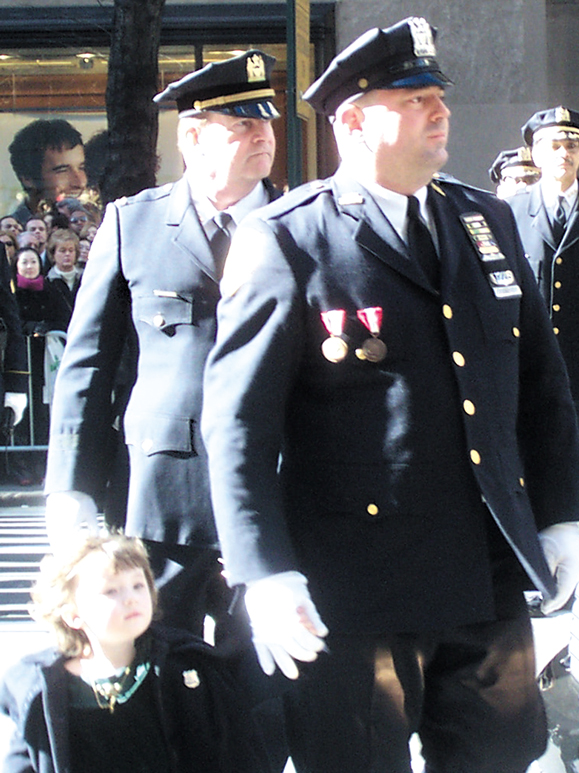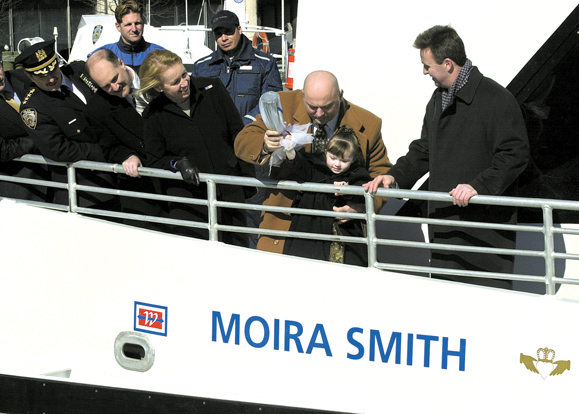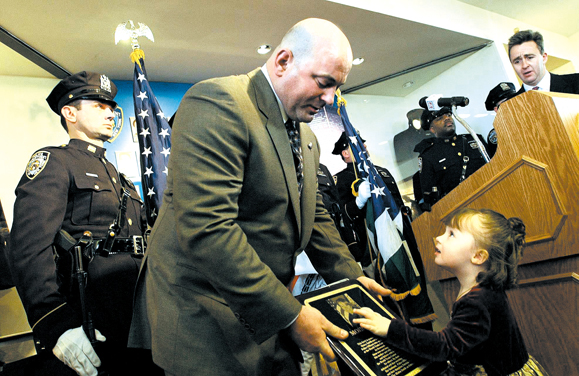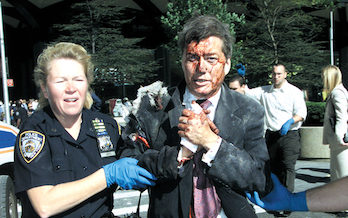Her name was Moira Ann Smith and she was a good cop from the neighborhood where I lived. I don’t know that I ever saw her on patrol in the Stuyvesant Town and Gramercy Park areas of Manhattan where she patrolled from the 13th Precinct. But in the days and weeks after September 11, I saw her face every day on the Missing posters along with her partner Robert Fazio, another good cop from the neighborhood. It seemed the two faces were everywhere, at the Ess a Bagel store, at the Emerald Card Store, and at Gristedes’ supermarket.
By the time of her memorial service more than five months after the event, I learned of her as a morn, a wife, a woman who loved the water and a rabble-rouser, a chancer who had run with the bulls in Spain, rode elephants in North Africa and skied the mountains in Jackson Hole, Wyoming — and pressed the local bishop in the Diocese of Brooklyn to let girls be altar servers. Longtime friend Cathy Simon theorized that Moira Ann’s campaign was motivated less by feminism or religious fervor than it was by the knowledge that all the altar boys were getting early dismissal from school once a week to practice.
She loved a crowd and a good time.
Her maiden name was Reddy, and growing up in Brooklyn, her longtime friend Kathleen Jacobs recalled that Moira Ann used to say it meant “Ready for anything.”
Moira Smith and Robert Fazio were probably two and a half to three miles away from the World Trade Center when the planes struck but they headed down to the stricken towers and helped lead people to safety. A photo that appeared in a local paper — one of the last pictures of her alive — showed her as she led someone to the safety of an ambulance. She then returned to the towers to try to rescue more of the victims of the attack.
Lissa Navarra, another police officer from the 13th Precinct recalled that when she saw the photo she wanted to scream, “Don’t go back in.”
“I know if I was standing next to her screaming in her ear to run, she would have gone back in to save just one more,”‘ said Navarra.
Moira was the only NYPD policewoman killed that day and only the second to die while on active service in the entire NYPD history.
Around the corner from the 13th Precinct, her husband Jim Smith was a police officer and instructor in the Police Academy.
One person from the neighborhood called the newspaper office where I was working on the morning of her memorial service and wanted to know if something big had happened again. “I’ve never seen so many cops on the streets.”
They were heading uptown to the memorial service of their fallen comrade.

It was February 14, 2002, Valentine’s Day. It would have been Moira Ann Smith’s 39th birthday. It also marked the 10-year anniversary of Moira’s first date with her future husband. They went to dinner and a Rangers game. Jim said it was because she always loved a crowd. “Her idea of a romantic vacation was one in which she only invited six of her closest friends,” he joked.
I don’t know that the funerals and memorial services get any easier over time, but for the thousands of cops who lined up for six blocks outside St. Patrick’s Cathedral that day, at first there was not that stunned silence that had accompanied the first funerals after 9/11.
Then the muffled drams of the NYPD Emerald Society band came thumping down Fifth Avenue and that eerie silence came over the crowd as it has too many times before. The police snapped to attention. Curious onlookers stopped and strained their necks and made no sound.
And then in the strange silence in the middle of Manhattan, you saw the unmarked police car with two-year-old Patricia Mary Smith in the front seat with her daddy slowly gliding down the avenue. It is always the kids who break your heart. She held a small stuffed animal. She seemed so tiny later in the front row of the huge cathedral that was packed to the brim.
In the long blue line of police officers outside, I notice a small boy holding the hand of an officer. He wears a brown coat and a cap that looked like it could have been swiped from one of the Bowery Boys. It was against regulations for the boy to be there, but no one seemed to mind. I watch as he breaks away from the officer and dashes across the street, having no trouble getting through the security, and hooking up with the person I presume to be his mom. You wonder what the connection was as you stand in the chill, but then you forget him in a flash and squint into the sun and stamp your feet.
You look at the long line of cops and realize that many are getting lost in their thoughts and more than a few do that blink, blink, blink and look up to the sky.
A day earlier, little Patricia Mary Smith had been at a service where a new ferry from New York Waterways was named the Moira Smith to honor her mom and the 22 comrades from the NYPD who perished that horrible day. Everything from neighborhood bars to boulevards and parks and schools will be renamed to remember the heroes. It’s a way for the living to try and get on with life — knowing they will never really get on the way it once was.
At the dedication of the ferry, Jim Smith recalled that after he and Moira returned from what would be their last vacation together in August, they had decided to give their beloved Winnebago, their traveling holiday home, to a children’s charity.
“As it was being towed away we both pretended to cry — some may say we weren’t pretending — and Patricia said, `Don’t worry, Daddy, I’ll buy you a new truck.'” To which Moira replied, “Hey, what about me?” And the baby said, “I’ll buy you a boat!”
Said Jim, “On the side of Moira Smith is a Claddagh, an Irish symbol meaning Friendship, Loyalty, and Love. This design embodies what Moira means to us: a good Friend, a Loyal police officer and American, and the Love of our lives. There is a traditional saying that goes with the giving of a Claddagh: `With these Hands I give you my Heart, and I Crown it with my Love.’
“God Bless Moira and God Bless all those who gave their lives in this fight for freedom. Thank you.”
A TV crew panned to the police honor guard, and even those hardened men of too many funerals had tears in their eyes.

The next day, the great cathedral was packed. Mayor Michael Bloomberg said he shared the same birthday — and had ridden on the ferry Moira Smith uptown that day. Police Commissioner Ray Kelly vowed to hunt down the people who had perpetrated the murders. There was a letter read from President George W. and Laura Bush.
But it was the people who had known her longest who spoke most eloquently and made you feel as if you knew her too. There was Allison Reddy, recalling her favorite aunt. “Whenever we spoke on the phone, she ended with the words, `I love you,'” said Reddy. “Her life is not defined by her final act, it is just the exclamation point on the life of my hero.”
And lifelong friend, Kathleen Jacobs, recalled how Moira Ann had actually managed to befriend the two grouchy ladies that everyone in the neighborhood had been afraid to approach. She also said she showed a penchant for policing at an early age, forming a “Give a Hoot, Don’t Pollute Club” and then handing out tickets to the neighborhood polluters.
“She died the way she lived,” said Simon, “surrounded by people she wanted to help in the job she loved.”
At the memorial, a woman sitting next to me tapped and said, “You won’t believe this, but today is my birthday as well.” There were cops from all over the country — two women from Toledo a few rows up. There were cops from Wilmington and Washington, D.C., and upfront there was even a member of the Royal Canadian Mounted Police, in that resplendent red uniform. One estimate said there were 10,000 cops there that day, and it was hard to doubt it as they overflowed the cathedral and spilled into the streets.
The woman next to me was Mary O’Mahoney, also a cop, she said, from the 26th Precinct and the mother of two. She had come, out of uniform, on her own birthday to be there. “I had to come,” she said. “The lesson I’ve learned from this is to put our family first and live every day to the fullest.”
Even in death, people who had never met her seemed to draw new inspiration from Moira Ann’s life.

That night coming home on the subway a string of helium-filled Valentine’s Day balloons went by, and as I turned to let them go out of the way, I inadvertently banged into a small boy. I looked down and saw that same brown coat and cap on the head of a wee lad that I had seen that day, standing with the cops outside St. Patrick’s.
“You were at the funeral today, weren’t you?” I blurted out to his mother, after apologizing profusely for nearly stepping on her son.
The funny thing in the days after September 11, you have conversations you never would have had before.
The mom, Margaret Crowe, filled me in. The boy was five-year-old Matthew. The coat was first purchased by the boy’s grandmother and worn first by his uncle, now a cop on Long Island, sometime in the 1950s. And as Irish families sometimes still do, it is “the good coat” handed down from kid to kid and sometimes from generation to generation. The dad, Brendan, is a NYPD cop, getting ready to put in the papers right after one last St. Patrick’s Day. He was the man holding the little boy’s hand.
“Did you know Moira?” I asked.
Said the mom, “We think we met her once — she patted Matthew on the head when he was out riding his bike and said, `Good job, you’re wearing your helmet.'”
Young Matthew had something else he did not have earlier that day. He was now wearing a backpack, and prominently placed in the back of the clear plastic container was the card that read: “In loving memory of Moira Ann Smith” and it showed her in a police uniform standing before an American flag.
“Ask him what he wants to be when he grows up,” the mom says.
“A police officer,” said the lad.
And as he disappears up the subway steps, with the picture of a smiling cop looking out the back of his backpack, you realize that we won’t be beaten.
Her name was Moira Ann Smith, a good cop from the neighborhood where I live. And she was so much more.
Her husband Jim Smith was a man of few words, but he captured so much of his wife’s spirit. He recalled how Moira Ann’s favorite movie was The Wizard of Oz. “We must have seen it 200 times,” he said as he delivered the farewell eulogy. He said he had only recently begun to comprehend one of the lines spoken by the Wizard.
“The Wizard told the Tin Man that a heart is not judged by how much you love, but by how much you are loved by others.”
And once again, the tough men — and women — who have been through so much, give it that blink, blink, blink, and squint and look up to the sky. ♦


Leave a Reply